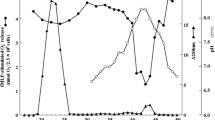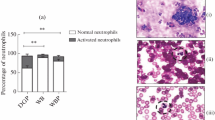Abstract
The effects of the macrolide antimicrobial agents azithromycin, clarithromycin, erythromycin and roxithromycin on the prooxidative activity of stimulated human neutrophils have been investigated in vitro. Superoxide generation by activated neutrophils was measured by lucigenin-enhanced chemiluminescence. At the concentrations used (2.5–80 μg/ml) none of the test agents was cytotoxic, nor did they possess superoxide-scavenging properties. Treatment of neutrophils with all 4 macrolides was accompanied by dose-related inhibition of superoxide production by cells activated with FMLP or the calcium ionophore (A23187), while the responses activated by phorbol myristate acetate (PMA) or opsonized zymosan were minimally affected. The anti-oxidative interactions of roxithromycin with FMLP-activated neutrophils were neutralized by pretreatment of the cells with low, non-cytotoxic concentrations (0.5 μg/ml) of the prooxidative, proinflammatory bioactive phospholipids, lysophosphatidylcholine (LPC), platelet-activating factor (PAF) and lyso-PAF (LPAF). Using an assay of membrane-stabilizing activity, the macrolides antagonized the membrane-disruptive effects of LPC, PAF and LPAF, without affecting enzymes involved in their synthesis. These membrane-stabilizing interactions of macrolides with neutrophils may counteract the proinflammatory, prooxidative activity of several bioactive lipids which have been implicated in the pathogenesis of bronchial asthma.
Similar content being viewed by others
References
Itkin, I. H., andM. L. Menzel. 1970. The use of macrolide antibiotic substances in the treatment of asthma.J. Allergy 45:146–162.
Spector, S. L., F. H. Katz, andR. S. Farr. 1974. Troleandomycin: effectiveness in steroiddependent asthma and bronchitis.J. Allergy Clin. Immunol. 54:367–379.
Suez, D., andS. J. Szefler. 1986. Excessive accumulation of mucus in children with asthma: a potential role for erythromycin? A case discussion.J. Allergy Clin. Immunol. 77:330–334.
Mihatake, H., K. Suzuki, F. Taki, K. Takagi, andT. Satake. 1991. Effect of erythromycin on bronchial hyperresponsiveness in patients with bronchial asthma.Arzneim. Forsch. Drug Res. 41:552–556.
Rosenberg, S. M., H. Gerhand, M. M. Grunstein, andC. M. Schramm. 1991. Use of TAO with or without methylprednisolone in the treatment of severe asthma.Chest 100:849–850.
Shimizu, T., M. Kato, H. Mochizuki, K. Tokuyama, K. Morikawa, andT. Kuroume. 1994. Roxithromycin reduces the degree of bronchial hyperresponsiveness in children with asthma.Chest 166:458–461.
Goswami, S. K., S. Kivity, andZ. Marom. 1990. Erythromycin inhibits respiratory glycoconjugate secretion from human airways in vitro.Am. Rev. Resp. Dis. 141:72–78.
Tamaoki, J., K. Isono, N. Sakai, T. Kanemura, andK. Konno. 1992. Erythromycin inhibits C1 secretion across canine tracheal epithelial cells.Eur. Respir. J. 5:234–238.
Takeyama, K., J. Tamaoki, A. Chiyotani, E. Tagaya, andK. Konno. 1993. Effect of macrolide antibiotics on ciliary motility in rabbit airway epithlium in vitro.J. Pharm. Pharmacol. 45:756–758.
Miyachi, Y., A. Yoshioka, S. Imamura, andY. Niwa. 1986. Effect of antibiotics on the generation of reactive oxygen species.J. Invest. Dermatol. 86:449–453.
Anderson, R. 1989. Erythromycin and roxithromycin potentiate human neutrophil locomotion by inhibition of leukoattractant-activated superoxide generation and autooxidation.J. Infec. Dis. 159:966–973.
Hirata, T., T. Izumi, andS. Oshima. 1989. Inhibitory effect of erythromycin on the production of oxygen radical and chemotactic factor for neutrophils.Am. Rev. Resp. Dis. 139:A484.
Labro, M. T., J. El Benna, andC. Babin-Chevaye. 1989. Comparison of the in vitro effect of several macrolides on the oxidative burst of human neutrophils.J. Antimicrob. Chemother. 24:561–572.
Hand, W. L., D. L. Hand, andN. L. King-Thomson. 1990. Antibiotic inhibition of the respiratory burst response in human polymorphonuclear leukocytes.Antimicrob. Agents Chemother. 34:863–870.
Umeki, S. 1993. Anti-inflammatory action of erythromycin: its inhibitory effect on neutrophil NADPH-oxidase activity.Chest 104:1191–1193.
Konno, S., M. Adachi, K. Asano, K. Okamoto, andT. Takahashi. 1993. Anti-allergic activity of roxithromycin: inhibition of interleukin-5 production from mouse T lymphocytes.Life Sci. 52:PL25–30.
Peters, D. H., H. A. Friedel, andD. McTavish. 1993. Azithromycin: a review of its antimicrobial activity, pharmacokinetic properties and clinical efficacy.Drugs 44:750–799.
Minkenberg, I., andE. Ferber. 1984. Lucigenin-dependent chemiluminescence as a new assay for NADPH-oxidase activity in particulate fractions of human polymorphonuclear leukocytes.J. Immunol. Meth. 71:61–67.
Anderson, R., A. D. Beyers, J. E. Savage, andA. E. Nel. 1988. Apparent involvement of phospholipase A2, but not protein kinase C, in the pro-oxidative interactions of clofazimine with human phagocytes.Biochem. Pharmacol. 37:4635–4641.
Holmsen, H. E., E. Storm, andH. J. Day. 1972. Determinations of ATP and ADP in blood platelets: a modification of the firefly luciferase assay for plasma.Analyt. Biochem. 46:481–502.
Neu, H. C. 1991. The development of macrolides: clarithromycin in perspective.J. Antimicrob. Chemother. 27(Suppl A): 1–9.
Puri, S. K., andH. B. Lassman. 1987. Roxithromycin: a pharmacokinetic review of a macrolide.J. Antimicrob. Chemother. 20(Suppl B):89–100.
Anderson, R., C. E. J. Van Rensburg, G. Joone, andP. T. Lukey. 1987. An in vitro comparison of the intraphagocytic bioactivity of erythromycin and roxithromycin.J. Antimicrob. Chemother. 20(Suppl B): 57–68.
Anderson, R., G. Joone, andC. E. J. Van Rensburg. 1988. An in vitro evaluation of the cellular uptake and intraphagocytic bioactivity of clarithromycin (A-56268, TE-031), a new macrolide antimicrobial agent.J. Antimicrob. Chemother. 22:923–933.
Gladue, R. P., G. M. Bright, R. E. Isaacson, andM. F. Newborg. 1989. In vitro and in vivo uptake of azithromycin (CP-62,993) by phagocytic cells: possible mechanism of delivery and release at sites of infection.Antimicrob. Agents Chemother. 33:277–282.
Ishiguro, M., H. Koga, S. Kohno, T. Hayashi, K. Yamaguchi, andM. Hirota. 1989. Penetration of macrolides into human polymorphonuclear leukocytes.J. Antimicrob. Chemother. 24:719–729.
Rubinek, T., andR. Levy. 1993. Arachidonic acid increases the activity of the assembled NADPH-oxidase in cytoplasmic membranes and endosomes.Biochim. Biophys. Acta. 1176:51–58.
Dana, R., H. L. Malech, andR. Levy. 1994. The requirement for phospholipase A2 for activation of the assembled NADPH-oxidase in human neutrophils.Biochem. J. 297:217–223.
Kusner, D. J., J. N. Aucott, D. Franceschi, M. M. Sarasua, S. J. Spagnuolo, andC. H. King. 1991. Protease priming of neutrophil superoxide production: effects on membrane lipid order and lateral mobility.J. Biol. Chem. 266:16465–16471.
Wiles, M. E., J. A. Dykens, andC. D. Wright. 1994. Regulation of polymorphonuclear leukocyte membrane fluidity: effect of cytoskeletal modification.J. Leuk. Biol. 56:192–199.
Zimmerman, G. A., S. M.Prescott, and T. M.McIntyre. Platelet-activating factor: a fluid phase and cell-associated mediator of inflammation;In Inflammation: Basic Principles and Clinical Correlates. Gallin JI, Goldstein IM, Snyderman R, eds. New York; Raven Press Ltd. 149–176.
Oishi, K., R. L. Raynor, P. A. Charp, andJ. F. Kuo. 1988. Regulation of protein kinase C by lysophospholipids.J. Biol. Chem. 263:6865–6871.
Savage, J. E., A. J. Theron, andR. Anderson. 1993. Activation of neutrophil membrane-associated oxidative metabolism by ultraviolet radiation.J. Invest. Dermatol. 101:532–536.
Engelberger, W., D. Bitter-Suermann, andU. Hadding. 1987. Influence of lysophospholipids and PAF on the oxidative burst.Internat. J. Immunopharmacol. 9:275–282.
Ginsburg, I., P. A. Ward, andJ. Varani. 1989. Lysophosphatides enhance superoxide responses of stimulated human neutrophils.Inflammation. 13:163–174.
Perry, D. K., W. L. Hand, D. E. Edmondsen, andJ. D. Lambeth, 1992. Role of phospholipase D-derived diradylglycerol in the activation of the human neutrophil respiratory burst oxidase-inhibition by phosphatidic acid phosphohydrolase inhibitors.J. Immunol. 149:2749–2758.
Aoshiba, K., A. Nayai, andK. Konno. 1995. Erythromycin shortens neutrophil survival by accelerating apoptosis.Antimicrob. Agents Chemother. 39:872–877.
Barnes, P. J. 1989. New concepts in the pathogenesis of bronchial hyperresponsiveness and asthma.J. Allergy Clin. Immunol. 83:1013–1026.
Mehta, D., S. Gupta, S. N. Gaur, S. V. Gangal, andK. P. Agrawal. 1990. Increased leukocyte phospholipase A2 activity and plasma lysophosphatidylcholine levels in asthma and rhinitis and their relationship to airway sensitivity to histamine.Am. Rev. Resp. Dis. 142:157–161.
Marquardt, D. L., andL. L. Walker. 1991. Lysophosphatidycholine induces mast cell secretion and protein kinase C activition.J. Allergy. Clin. Immunol. 88:721–730.
Ganbo, T., K. Hisamatsu, T. Nakazawa, A. Kanjo, andY. Murakami. 1991. Platelet activating factor (PAF) effects on ciliary activity of human paranasal sinus mucosa in vitro.Rhinology. 29:231–237.
Nieminen, M. M., E. K. Moilanen, J-E. J. Nyholm, M. O. Koskinen, J. I. Karvonen, T. J. Metsä-Ketelä, andH. Vapaatalo. 1991. Platelet-activating factor impairs mucociliary transport and increases plasma leukotriene B4 in man.Eur. Respir. J. 4:551–560.
Feldman, C., R. Anderson, A. Theron, P. J. Cole, andR. Wilson. 1995. The effects of platelet activating factor (PAF) and lysophosphatidylcholine (LPC) on human ciliated epithelium in vitro.Am. J. Resp. Crit. Care Med. 151:A65.
Hovi, T., K. Josefesson, andO. V. Renkonen. 1983. Erythromycin absorption in healthy volunteers from single and multiple doses of enteric-coated pellets and tablets.Eur. J. Clin. Pharmacol. 25:719–729.
Author information
Authors and Affiliations
Rights and permissions
About this article
Cite this article
Anderson, R., Theron, A.J. & Feldman, C. Membrane-stabilizing, anti-inflammatory interactions of macrolides with human neutrophils. Inflammation 20, 693–705 (1996). https://doi.org/10.1007/BF01488805
Issue Date:
DOI: https://doi.org/10.1007/BF01488805




